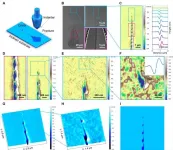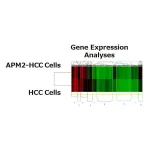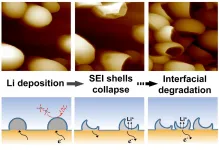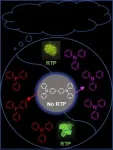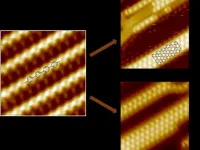Massive X-ray screening identifies promising candidates for COVID drugs
DESY's X-ray lightsource PETRA III reveals existing active substances binding to key virus protein
2021-04-02
(Press-News.org) A team of researchers has identified several candidates for drugs against the coronavirus SARS-CoV-2 at DESY´s high-brilliance X-ray lightsource PETRA III. They bind to an important protein of the virus and could thus be the basis for a drug against Covid-19. In a so-called X-ray screening, the researchers, under the leadership of DESY, tested almost 6000 known active substances that already exist for the treatment of other diseases in a short amount of time. After measuring about 7000 samples, the team was able to identify a total of 37 substances that bind to the main protease (Mpro) of the SARS-CoV-2 virus, as the scientists report online today in the journal Science. Seven of these substances inhibit the activity of the protein and thus slow down the multiplication of the virus. Two of them do this so promisingly that they are currently under further investigation in preclinical studies. This drug screening - probably the largest of its kind - also revealed a new binding site on the main protease of the virus to which drugs can bind.
In contrast to vaccines, which help healthy people to defend themselves against the virus, drug research is looking for drugs that slow down or stop the reproduction of the virus in the body of people who are already infected. Viruses cannot reproduce on their own. Instead, they introduce their own genetic material into the cells of their host and make them produce new viruses. Proteins such as the main protease of the virus play an important role in this process. Protease cuts protein chains produced by the host cell according to the blueprint of the virus genetic material into smaller parts that are necessary for the reproduction of the virus. If the main protease can be blocked, the cycle can possibly be interrupted; the virus can no longer reproduce and the infection is defeated.
Beamline P11 of DESY´s PETRA III research lightsource specialises in structural biology studies. Here, the three-dimensional structure of proteins can be imaged with atomic precision. The research team led by DESY physicist Alke Meents used this special capability to examine several thousand active substances from a library of the Fraunhofer Institute for Translational Medicine and Pharmacology and another library from the Italian company Dompé Farmaceutici SpA to see whether and how they "dock" to the main protease - the first important step in blocking it. Like a key in a lock, the drug molecule fits into a binding centre of the protease. The advantage of the drug library is that it contains active substances that have already been approved for the treatment of humans or those that are currently in various testing phases. Suitable candidates to combat SARS-CoV-2 could therefore be used in clinical trials considerably faster, saving months or years of drug development.
The special technical equipment at the PETRA III station P11 includes fully automated sample changes with a robotic arm, so that each of the more than 7000 measurements took only about three minutes. With the help of automated data analysis, the team was able to quickly separate the wheat from the chaff. "Using a high-throughput method, we were able to find a total of 37 active substances that bind with the main protease," says Meents, who initiated the experiments.
In a next step, the researchers at the Bernhard Nocht Institute for Tropical Medicine investigated whether these active substances inhibit or even prevent virus replication in cell cultures and how compatible they are for the host cells. This reduced the number of suitable active substances to seven, two of which stood out in particular. "The active substances Calpeptin and Pelitinib clearly showed the highest antivirality with good cell compatibility. Our cooperation partners have therefore already started preclinical investigations with these two substances," explains DESY researcher Sebastian Günther, first author of the Science publication.
In their drug screening using protein crystallography, the researchers did not examine fragments of potential drugs as is usually the case, but complete molecules of the drug. In the process, however, the team of more than 100 scientists also discovered something completely unexpected: they found a binding site on the main protease that had been completely unknown until then. "It was not only a nice surprise that we were able to discover a new drug binding site on the main protease - a result that can really only be achieved at a synchrotron light source like PETRA III - but that even one of the two promising drug candidates binds precisely to this site," says Christian Betzel from the excellence cluster CUI of the University of Hamburg, co-initiator of the study.
"A particular strength of our method of X-ray screening compared to other screening methods is that we obtain the three-dimensional structure of the protein-drug complexes as a result and can thus identify the binding of the drugs to the protein at the atomic level. Even if the two most promising candidates do not make it into clinical trials, the 37 substances that bind to the main protease form a valuable database for drug developments based on them," explains Patrick Reinke, DESY researcher and co-author of the publication.
"The investigations at PETRA III impressively show how relevant high-brilliance synchrotron lightsources are for the development of future medicines and for health research as a whole," stresses Helmut Dosch, Chairman of the DESY Directorate. "We must and want to expand our infrastructures even more in the future to cope with health crises like the current one."
INFORMATION:
In addition to DESY scientists, researchers from the Universities of Hamburg and Lübeck, the Bernhard Nocht Institute for Tropical Medicine, the Fraunhofer Institute for Translational Medicine and Pharmacology, the Heinrich Pette Institute, the European XFEL, the European Molecular Biology Laboratory EMBL, the Max Planck Society, the Helmholtz-Zentrum Berlin and other institutions are involved in the work. In addition to the experiments at the P11 measuring station, measurements were also carried out at the EMBL measuring stations P13 and P14 at PETRA III.
DESY is one of the world's leading particle accelerator centres and investigates the structure and function of matter - from the interaction of tiny elementary particles and the behaviour of novel nanomaterials and vital biomolecules to the great mysteries of the universe. The particle accelerators and detectors that DESY develops and builds at its locations in Hamburg and Zeuthen are unique research tools. They generate the most intense X-ray radiation in the world, accelerate particles to record energies and open up new windows onto the universe. DESY is a member of the Helmholtz Association, Germany's largest scientific association, and receives its funding from the German Federal Ministry of Education and Research (BMBF) (90 per cent) and the German federal states of Hamburg and Brandenburg (10 per cent).
Reference:
X-ray screening identifies active site and allosteric inhibitors of SARS-CoV-2 main protease; Sebastian Günther, Patrick Y. A. Reinke, et al.; Science, 2021; DOI: 10.1126/science.abf7945
ELSE PRESS RELEASES FROM THIS DATE:
2021-04-02
Glassy materials play an integral role in the modern world, but inherent brittleness has long been the Achilles' heel that severely limits their usefulness. Due to the disordered amorphous structure of glassy materials, many mysteries remain. These include the fracture mechanisms of traditional glasses, such as silicate glasses, as well as the origin of the intriguing patterned fracture morphologies of metallic glasses.
Cavitation has been widely assumed to be the underlying mechanism governing the fracture of metallic glasses, as well as other glassy systems. Up until now, however, scientists ...
2021-04-02
A new study indicates holes the solution to operational speed/coherence trade-off, potential scaling up of qubits to a mini-quantum computer.
Quantum computers are predicted to be much more powerful and functional than today's 'classical' computers.
One way to make a quantum bit is to use the 'spin' of an electron, which can point either up or down. To make quantum computers as fast and power-efficient as possible we would like to operate them using only electric fields, which are applied using ordinary electrodes.
Although spin does not ordinarily 'talk' to electric fields, in some materials spins can interact with electric fields indirectly, and these are some of the hottest materials currently studied ...
2021-04-02
In May 2020, a team led by thoracic surgeon Konrad Hoetzenecker of the Department of Surgery of MedUni Vienna and Vienna General Hospital performed a lung transplant on a 44-year-old patient who had been seriously ill with Covid-19, making her the first patient in Europe to receive a lung transplant for this indication. The Vienna lung transplantation programme now plays a leading role in an international consortium comprising experts from the USA, Europe and Asia. Based on the expertise from Vienna, approximately 40 transplants have now been carried out on Covid-19 patients throughout the world. In a study published in the leading journal ...
2021-04-02
Russian researchers have developed an inexpensive, safe, and reliable packed eggs surface disinfection technology. This technology helps to kill bacteria, including salmonella, on eggshells. Also, it allows growing broiler chickens with strong immunity to viral diseases. Packed eggs are disinfected with 50 nanoseconds (one billionth of a second) electron beam. Disinfection takes place in plastic containers. The description of the technology was published in Food and Bioproducts Processing.
"Disinfection of the packed eggs protects eggs from subsequent contamination during storage", said Sergey Sokovnin, a professor at Ural Federal University and Ural Branch of Russian Academy of Science. "We found out that 5 kGy is enough for disinfection. Such dose allows to ...
2021-04-02
Niigata, Japan - Cancer is the world's second deadliest disease which contributes towards the fatality of over 10 million people per year. Oncologists adopt a variety of treatment procedures to treat cancer cells. Among the different methods used to fight cancer, chemotherapeutic treatment is a prominent and well-adopted technique. It is a drug based method, wherein powerful chemical compounds are injected into the body to annihilate the malignant cells. Although these chemicals support the destruction of the cancerous cells, optimizing their dosage has always been a challenge to the medical ...
2021-04-02
In United Nations Sustainable Development Goals, Number 6, addresses the need for access to clean water and sanitation for all. In the worldwide situation, one in three people do not have access to safe drinking water, and two out of five do not have basic hand-washing facilities with soap and water.
Water quality also address to elements dissolved. In the case of fluoride, controlled amount are recommended for protect tooth, e.g. included in toothpaste. Higher levels can cause fluorosis, interfere in tooth enamel formation, correct growth of the bones, and cause crippling deformities of the spine and joints. The incidence of higher concentrations of fluoride in water is higher in rural areas without ...
2021-04-02
Eczema, or atopic dermatitis (AD), is sometimes called "the itch that rashes." Often, the itch begins before the rash appears, and, in many cases, the itchiness of the skin condition never really goes away. Approximately 9.6 million children and 16.5 million adults in the U.S. have AD, which can have a serious effect on quality of life for patients. Although much has been learned about the uncomfortable sensation that triggers the desire to scratch, many mysteries remain about chronic itch, making it a challenge to treat. A paper by authors from Brigham and Women's Hospital and Harvard Medical School published in The Proceedings ...
2021-04-02
The interfacial decomposition products forming the so-called solid-electrolyte interphase (SEI) during the first charging/discharging significantly determine the electrochemical performances of lithium (Li) batteries. To date, the dynamic evolutions, chemical compositions, stabilities and the influencing factors of the SEI films have been captured tremendous attentions.
It's noted that, in contrast to the SEI film formation at the surface of electrodes, a kind of SEI shells usually conformally forms at the outmost layer of the on-site deposited Li once the freshly deposited Li contacts with the electrolyte, which could directly influence Li nucleation, growth behaviors ...
2021-04-02
Purely organic room-temperature phosphorescence (RTP) materials have been a hot research topic. Currently, the pure RTP materials have been realized by the introduction of heavy halogen atoms, carbonyls groups or some heteroatoms, hydrogen bonding, H-aggregation, strong intermolecular electronic coupling, molecular packing, host-guest interaction, etc. However, the complicated synthesis and high expenditure are still inevitable in these systems. In addition, their performances in air are not satisfactory and the introduction of halogen atoms is generally necessary. Therefore, a new facile and robust host-guest strategy utilizing only electron-rich materials is a promising alternative for constructing RTP systems.
Very ...
2021-04-02
On-surface synthesis has received great attention as a method to create atomically-precise one-dimensional (1D) and two-dimensional (2D) polymers with intriguing properties. In particular, graphene nanoribbons (GNRs), a category of quasi-1D nanomaterials derived from graphene, have been widely studied due to their tunable electronic properties and potential applications in semiconductor devices, such as field-effect transistors and spintronics. A series of top-down approaches have been pursued to produce GNRs, but a lack of control over the ribbon width and edge structure has hindered their further development.
In 2010, Cai et al. firstly reported the fabrication of an atomically-precise armchair GNR (AGNR) on the Au(111) surface using a bottom-up ...
LAST 30 PRESS RELEASES:
[Press-News.org] Massive X-ray screening identifies promising candidates for COVID drugs
DESY's X-ray lightsource PETRA III reveals existing active substances binding to key virus protein
